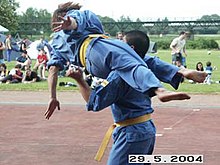
A scissor kick in martial arts is any of certain kicking or grabbing techniques that resemble a pair of scissors. [1] [2]

A scissor kick in martial arts is any of certain kicking or grabbing techniques that resemble a pair of scissors. [1] [2]
It may describe a mid-air kick in which both legs are swung or kicked out in different directions to strike two opponents simultaneously or in rapid succession. This is particularly common in some schools of Taekwondo, Vovinam, and some Chinese martial arts, also in Silat and Pencak Silat where it is referred to as Gunting (in Malay language).
In sanshou, the scissor kick is used as a mid air take down where one leg presses on the opponent's chest while the other leg positioned behind the opponent's knees, and is delivered with enough symmetrical force to knock the opponent down; the scissor leg take down is one of the more advanced take downs in san shou and is an effective tool used in many matches. [3]
In Judo, Kani basami, also known as Kane Sute in Danzan-ryū, is classified as a sacrifice throw, known as "scissors throw." It is less of a strike however and tends to be more similar to a foot sweep.
This move is also well known in the professional wrestling world among many wrestlers and fans. The attacker jumps (from a standing or running position) using one leg for momentum and drives the other leg into the back of the head and the neck of the opponent.
Throughout his career, Booker T, a former wrestler in WWE, WCW, and TNA, is credited to having popularizing the move in the United States.
Various other wrestlers who uses this technique, such as former WWE wrestler Bull Buchanan and former TNA wrestler and current WWE wrestler Ron Killings, currently known as R-Truth, uses this as a regular move but performs a corkscrew variation of the move.
WWE Diva Alicia Fox and FCW Diva Caylee Turner use the scissor kick as a finishing move.
NXT Superstar Carmelo Hayes uses a top-rope variation of the scissor kick as a finisher, referred to as Nothing But Net.
There are also different versions of this moved used in Capoeira takedowns.

A kick is a physical strike using the leg, in unison usually with an area of the knee or lower using the foot, heel, tibia (shin), ball of the foot, blade of the foot, toes or knee. This type of attack is used frequently by hooved animals as well as humans in the context of stand-up fighting. Kicks play a significant role in many forms of martial arts, such as capoeira, kalaripayattu, karate, kickboxing, kung fu, wing chun, MMA, Muay Thai, pankration, pradal serey, savate, sikaran, silat, taekwondo, vovinam, and Yaw-Yan. Kicks are a universal act of aggression among humans.

Filipino martial arts (FMA) refer to ancient and newer modified fighting methods devised in the Philippines. It incorporates elements from both Western and Eastern Martial Arts; the most popular forms of which are known as Arnis, Eskrima, and Kali. The intrinsic need for self-preservation was the genesis of these systems. Throughout the ages, invaders and evolving local conflict imposed new dynamics for combat in the islands now making up the Philippines. The Filipino people developed battle skills as a direct result of an appreciation of their ever-changing circumstances. They learned, often, out of necessity on how to prioritize, allocate and use common resources in combative situations. Filipinos have been heavily influenced by a phenomenon of cultural and linguistic mixture. Some of the specific mechanisms responsible for cultural and martial change extended from phenomena such as war, political and social systems, technology, and trade and practicality.
Professional wrestling throws are the application of professional wrestling techniques that involve lifting the opponent up and throwing or slamming them down. They are sometimes also called "power" maneuvers, as they are meant to emphasize a wrestler's strength. Many of these moves are used as finishers by various wrestlers, who refer to them by several different names that reflect their gimmick. Moves are listed under general categories whenever possible.
Professional wrestling holds include a number of set moves and pins used by performers to immobilize their opponents or lead to a submission. This article covers the various pins, stretches and transition holds used in the ring. Some wrestlers use these holds as their finishing maneuvers, often nicknaming them to reflect their character or persona. Moves are listed under general categories whenever possible.

A strike is a directed, forceful physical attack with either a part of the human body or with a handheld object, intended to cause blunt or penetrating trauma upon an opponent.
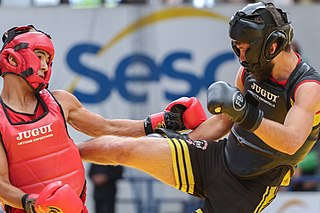
Sanda, formerly Sanshou, is the official Chinese boxing full-contact combat sport. In Chinese Language, "Sanda" originally referred to independent and separate training and combat techniques in contrast to "Taolu".
Aerial techniques, also known as "high-flying moves" are performance techniques used in professional wrestling for simulated assault on opponents. The techniques involve jumping from the ring's posts and ropes, demonstrating the speed and agility of smaller, nimble and acrobatically inclined wrestlers, with many preferring this style instead of throwing or locking the opponent.
Strikes can be offensive moves in professional wrestling, that can sometimes be used to set up an opponent for a hold or for a throw. There are a wide variety of strikes in pro wrestling, and many are known by several different names. Professional wrestlers frequently give their finishers new names. Occasionally, these names become popular and are used regardless of the wrestler performing the technique.
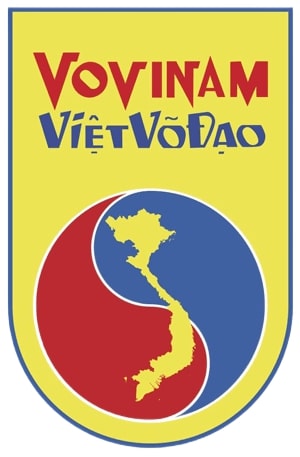
Vovinam, officially known as Việt Võ Đạo is a Vietnamese martial art founded in 1938 by Nguyễn Lộc. It is based on traditional Vietnamese eclectic sources.
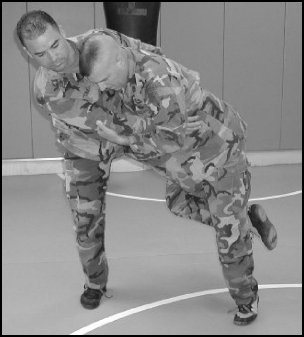
In martial arts and combat sports, a takedown is a technique that involves off-balancing an opponent and bringing them to the ground with the attacker landing on top. The process of quickly advancing on an opponent and attempting a takedown is known as shooting for a takedown, or simply shooting. Takedowns are usually distinguished from throws by amplitude and impact, where the purpose of a throw is to outright eliminate the opponent while purpose of a takedown is to bring the opponent down on the ground, assume a dominant position and then proceed to finish them with jointlocks, chokeholds, or ground and pound.

In martial arts and tricking, the 540 kick is a jump kick move. It involves a rotation of approximately 540 degrees.

A butterfly kick or horse kick is a jumping kick in martial arts such as modern wushu, taekwondo and capoeira. In certain changquan styles, this kick is known as Swallow Kick.

The foot sweep is a move in many different styles of martial arts. It refers to the use of any part of the foot or leg to trip an opponent or cause them to lose balance. Foot sweeps as an act of human aggression have likely existed worldwide since prehistory, which explains why it is prevalent in many martial arts across the world. However, the earliest documentation of foot sweeps used in self-defense, sport fighting and combat is seen in Chinese Martial arts, Judo, Jujutsu as well as Karate and Muay Thai.

Pencak silat is an umbrella term for a class of related Indonesian martial arts. In neighbouring countries, the term usually refers to professional competitive silat. It is a full-body fighting form incorporating strikes, grappling, and throwing, in addition to weaponry. Every part of the body is used and subject to attack. Pencak silat was practiced not only for physical defense but also for psychological ends. There are hundreds of different pencak silat styles and schools which tend to focus either on strikes, joint manipulation, weaponry, or some combination thereof.

A roundhouse kick is a kick in which the practitioner lifts the knee while turning the supporting foot and body in a semicircular motion, extending the leg striking with the lower part of the shin and/or the instep. The ball of the foot can also be used to strike the target and is preferable when power breaking thick boards. This type of kick is utilized in many different martial arts and is popular in both non-contact and full-contact martial arts competitions. The kick has many variations based on stance, leg movement, striking surface, and the height of the kick.

A grappling hold, commonly referred to simply as a hold that in Japanese is referred to as katame-waza, is any specific grappling, wrestling, judo, or other martial art grip that is applied to an opponent. Grappling holds are used principally to control the opponent and to advance in points or positioning. The holds may be categorized by their function, such as clinching, pinning, or submission, while others can be classified by their anatomical effect: chokehold, headlock, joint-lock, or compression lock. Multiple categories may be appropriate for some of these holds.
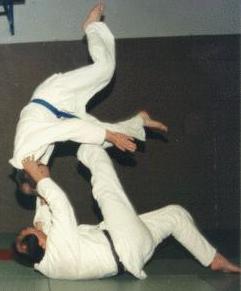
In martial arts, a throw is a grappling technique that involves off-balancing or lifting an opponent, and throwing them to the ground, in Japanese martial arts referred to as nage-waza, 投げ技, "throwing technique". Throws are a subset of takedown (grappling). Certain throwing techniques called sacrifice throws involve putting oneself in a potentially disadvantageous position, such as on the ground, in order to execute a throw.

Enshin kaikan (円心会館) is a style of "full contact karate", or knockdown karate, founded in 1988 with dojo and students in various countries around the world.

Kata guruma (肩車) is one of the traditional forty throws of judo as developed by Kano Jigoro. Kata guruma belongs to the third group of the traditional throwing list in the Gokyo no waza of the Kodokan Judo. It is also part of the current 67 Throws of Kodokan Judo. Because the technique is not a sweep nor a trip and requires tori to pull uke into a carry, it is categorized as a hand throwing technique (tewaza).
(Wayback Machine copy)